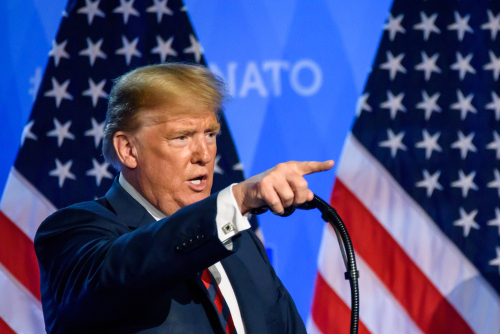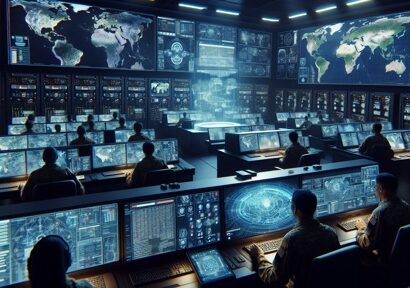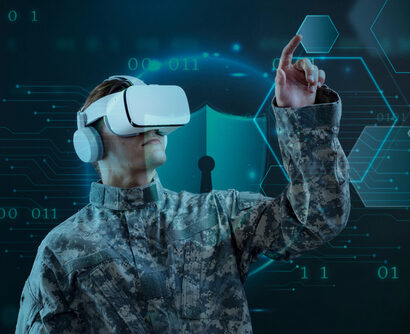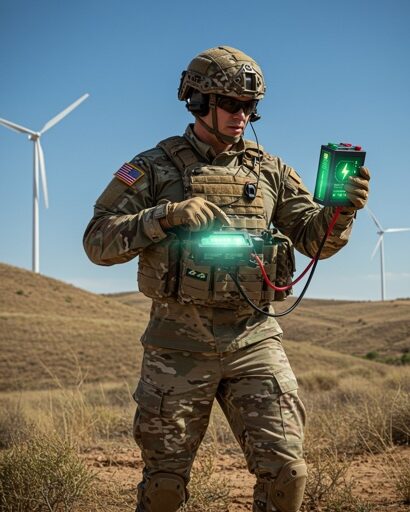Abstract: NATO members can ensure that the U.S. continues playing a leadership role in the transatlantic alliance during the second Trump Administration and beyond. The alliance must continue adapting to changing geopolitical dynamics marked by the emergence of an alternative axis comprising Russia, the People’s Republic of China, the Democratic People’s Republic of North Korea, and Iran. European NATO members must appreciate Trump’s scepticism towards NATO and acknowledge his first administration’s success in leveraging that scepticism to boost military budgets.
Problem statement: Does the return of Donald Trump to the White House raise concerns about NATO’s relevance and credibility?
So what?: To keep the U.S. as a reliable NATO ally under Trump, NATO will need to continue increasing defence spending and enhancing capabilities. They must adopt a strategic vision that recognises the coordination among the People’s Republic of China, Russia, Iran, and North Korea, and work with the U.S. in engaging with Japan, South Korea, Australia, and New Zealand.

Source: shutterstock.com/Gints Ivuskans
Trump’s Return to the White House
Donald Trump’s return to the White House presents several challenges to NATO and its member states. While most U.S. presidents have criticised the alliance, as it makes for good domestic politics, Trump was the most vocal in his criticism of NATO. In his first term, Trump questioned the foundation of NATO and indicated that the U.S. could reconsider its commitments to the alliance if European members did not increase defence spending. Although the second Trump Administration will challenge NATO, it could push the alliance to evolve and adapt to a rapidly changing threat landscape in Europe and beyond.
Consequently, one of the first to congratulate Trump was NATO Secretary General Mark Rutte. Rutte stated, “I just congratulated @realDonaldTrump on his election as President of the United States. His leadership will again be key to keeping our Alliance strong.”[1] However, to “Trump-proof” the alliance, European members must adopt several strategic measures to ensure the alliance’s cohesion and hedge against upcoming shifts in U.S. national security policy.
To “Trump-proof” the alliance, European members must adopt several strategic measures to ensure the alliance’s cohesion and hedge against upcoming shifts in U.S. national security policy.
In many ways, Rutte may be best suited to work with Trump. During Trump’s first administration, as Prime Minister of the Netherlands, Rutte was nicknamed “the Trump whisperer” for his pragmatic and frank approach in navigating headwinds with the often tumultuous and unpredictable president.[2] Trump’s earlier statements about Russian ambitions in Europe will prompt Rutte to push alliance members to raise defence spending and enhance security cooperation with the U.S. While Rutte is NATO’s best hope for working with the second Trump Administration, risks and serious challenges remain.
Trump’s nomination of former acting U.S. Attorney General Matthew Whitaker as U.S. Ambassador to NATO demonstrates his doubts about the alliance and his view that the U.S. shoulders an undue military burden. While Whitaker has little direct experience in diplomacy or military affairs, Trump described him as a “steadfast patriot” and “dedicated warrior” who will promote U.S. national interests within NATO and reinforce relationships with allies.[3] It could also be seen as a continuation of Trump’s “America First” foreign policy from his first administration.
Whitaker’s nomination could have several implications for NATO allies. It will increase pressure on members to boost defence budgets, effectively aligning them with Trump’s demands. While Trump is certainly not the first American president to criticise NATO members for lacklustre defence spending, he has been the most vocal in linking U.S. support with financial contributions. Another implication is that Whitaker’s appointment could shift U.S. commitments toward a “two-tier” NATO system in which members that fail to boost defence spending may receive less security guarantees from the U.S. [4] This could alter alliance unity and water down the collection security principle. Moreover, while it is too difficult to predict, Trump could negotiate with Russia, thereby undermining NATO’s position on Russia’s war in Ukraine.
Trump’s transactional approach to NATO and his pressure on allies to boost defence expenditures are not predictors of a U.S. withdrawal from the alliance. The reality is that NATO is interwoven into the fabric of U.S. national security. The alliance serves as an institutional mechanism that allows the U.S. to project strategic global leadership, rely on a network of reliable allies, share defence costs, counter-terrorism, share military investments, boost cyber assets, collaborate in intelligence gathering, and enhance deterrence. The U.S. depends on NATO allies Italy and Greece for its Mediterranean fleet and Germany for its Air Force and support operations.[5] Additionally, the National Defence Authorization Act of 2024 prevents any president from withdrawing the U.S. from NATO in the absence of two-thirds congressional approval.[6]
The National Defence Authorization Act of 2024 prevents any president from withdrawing the U.S. from NATO in the absence of two-thirds congressional approval.
Moreover, NATO continues to receive U.S. public support. A 2024 survey shows that most Americans (58%) have positive views of NATO despite declining support from Republicans and some independents. Furthermore, roughly two-thirds of Americans believe the U.S. enjoys many advantages in maintaining membership in NATO.[7] NATO leaders should continue stressing the benefits of NATO to the U.S. even though this would feed into Trump’s transactional approach to the alliance.
A Burgeoning Alternative Axis of Power
The world is a different place in 2024 than it was in 2021. America’s state adversaries are now more unified and menacing than ever. The second Trump Administration will need NATO to serve as an institutional vehicle for confronting the emergence of an alternative axis of power comprised of Russia, the People’s Republic of China (PRC), and North Korea (DPRK). This axis has its origins in the Russia-PRC “no limits” partnership that took shape just prior to Russia’s full-scale invasion of Ukraine in February 2022. The destructiveness of Russia’s war and Ukraine’s resistance expanded this partnership to include Iran and North Korea, which have provided Russia with military support that has allowed Russia to continue its war of aggression and possibly extend the violence into NATO member states. The international system is now defined as a bifurcated Cold War 2.0 that includes security, economic, and technological competition.[8]
Apparently, nowhere in the world is resistance to the U.S. and NATO more on display than in Ukraine, where the PRC, Iran, and North Korea are sustaining Russian aggression. President Volodymyr Zelensky notably congratulated Trump on his decisive electoral victory, stating “I appreciate President Trump’s commitment to the ‘peace through strength’ approach in global affairs. This is exactly the principle that can practically bring just peace in Ukraine closer. I am hopeful that we will put it into action together.”[9]
The continuation of U.S. support for Ukraine under Trump is critical. Since its full-scale invasion in February 2022, Russia has been boosting its military production. Ukrainian intelligence estimates that Russia can produce around 300-350 Shahed drones per month, which aligns with the number of Ukrainian intercepts and a total number of attacks.[10] According to a 2023 estimate from the U.S. Defence Intelligence Agency, when Russia started using Shaheds in Ukraine in September 2022, the vehicles were imported from mass production sites in Iran.[11] Since that time, Shaheds captured or shot down over Ukraine show that the Iranian vehicles are now being assembled in Russia, a clear indication that Russian and Iranian defence industrial bases are merging.[12]
Shaheds captured or shot down over Ukraine show that the Iranian vehicles are now being assembled in Russia, a clear indication that Russian and Iranian defence industrial bases are merging.
Also, artillery has become critical in Ukraine, and Russia has fired more shells than it can produce. At the start of the war, the U.S. and NATO members sanctioned Russian military production, forcing it to improvise and avoid sanctions at first. Although the PRC has sent spare parts and military technologies to Russia, it may not be willing to send artillery shells given that it needs them for a full-scale assault against Taiwan or does not want to risk further erosions in international trade with the U.S. or European Union (EU).[13]
North Korea has emerged as a key supplier of artillery to Russia to meet its needs. North Korea supplied more than 2.5 million artillery shells to boost the Russian arsenal.[14] The Korean peninsula is the world’s repository of well-maintained artillery shells, and North Korea and South Korea are still technically at war even though there has been an uneasy armistice for more than 70 years.[15]
Even more dangerous and destabilising is Russia training North Korean military recruits for deployment to Ukraine. The U.S. Department of Defence confirms that 10,000 DPRK soldiers are in Russia’s Kursk Oblast and estimates that number could reach 12,000 and may join Russian military forces in Ukraine.[16] Just two days after Trump’s electoral victory, NATO highlighted the strengthening military relationship between North Korea and Russia and the extent to which it impacts transatlantic security with consequences for the Indo-Pacific region, especially Japan, South Korea, Australia, and the Philippines.[17]
The Kremlin is struggling to replenish the more than 600,000 Russian troops killed or wounded since February 2022 and recruiting 25,000 to 30,000 new Russian soldiers per month to replace troops killed.[18] Moreover, the DPRK is providing ballistic missiles to Russia.[19] The Trump Administration and NATO members should take very seriously the broader implications of this military coordination between Russia and the DPRK.
Russia’s prolonged war in Ukraine and its strategic and operational difficulties have made PRC leaders concerned about making too many overt military commitments to Russia as that could provoke the U.S. and jeopardize economic relations with the West.[20] Although the PRC has been somewhat risk-averse, it is still playing a pivotal role in sustaining Russia’s war effort in Ukraine. The PRC is increasing its energy imports of Russian oil and natural gas, thereby providing billions of dollars to the sanctioned Russian economy.[21] The PRC is also supplying Russia with advanced military technologies, including critical components such as semiconductors and other devices for radar systems and fighter jets.[22]
Ukraine symbolises resistance against authoritarian regimes and a frontline test of NATO’s collective security commitment. Solidarity exhibited by NATO members in supplying assistance aid to Ukraine contrasts with the collaboration seen among the alternative axis members. This creates a critical narrative underlining the ideological struggle between democracy and authoritarianism in Cold War 2.0.[23]
Ukraine symbolises resistance against authoritarian regimes and a frontline test of NATO’s collective security commitment.
NATO Must Evolve… With an Eye on Trump
To address potential concerns about Trump’s commitment to NATO, the alliance should emphasise the progress made during his first term, particularly in increasing European defence spending. Two-thirds of NATO members now spend at least 2% of their GDP on defence, a trend that began during Trump’s previous presidency.[24] NATO leaders should continue pushing for increased defence spending and capabilities among members by considering higher targets like 2.5% or 3% of GDP, as suggested by Trump.[25]
The U.S. and NATO must lead the response to this alternative axis. In the wake of its 2022 meeting in Madrid, NATO developed a new Strategic Concept to state that Russia is “the most significant and direct threat to allies’ security and to peace and stability in the Euro-Atlantic area” and acknowledged the PRC’s “stated ambitions and coercive policies” that stands as a “challenge our interests, security and values.”[26] But NATO must be more persistent in making this alternative axis a priority as Russia, the PRC, Iran, and the DPRK have aligned more closely since Russia launched its war in Ukraine.
NATO members should also address vulnerabilities that allow Russia to wage sabotage and malign operations. For example, reports show that Russia’s foreign military intelligence agency, Glavnoye Razvedyvatelnoye Upravlenie (GRU), plans to deploy incendiary devices on cargo planes to set fires at shipping hubs in Germany and the UK. There is a possibility that such operations are designed to ultimately target the U.S. and its allies in retaliation for providing security assistance to Ukraine. This is a major escalation in Russian operations that shows the Kremlin’s willingness to shift from not provoking NATO allies, given Russia’s fears of escalating its war in Ukraine, toward one that includes increasing hostilities against Ukraine’s primary supporters. It reflects Russia’s trend of expanding its hybrid war tactics of disinformation, cyberattacks, and now sabotage against NATO members to damage European and American logistics hubs.[27]
NATO members should also address vulnerabilities that allow Russia to wage sabotage and malign operations.
Russia has also sought to wage malign operations in the grey zone by obstructing the movement of European states seeking greater integration within Euro-Atlantic institutions. Russia backs pro-Russia groups in Serbia’s ethnonationalist and Orthodox groups against Kosovo and exacerbates divisions within Bosnia’s fragmented federalist structures to complicate efforts at NATO and EU integration.[28] The continuation of tensions between Kosovo and Serbia allows Russia to extend its support to threaten actors seeking to prevent the normalisation of relations.[29] Kosovo needs a pathway to NATO membership, and Serbia a pathway to EU membership. Furthermore, in Bosnia and Herzegovina, Russia openly supports local actors and pro-Russia leader in Republika Srpska, Milorad Dodik, who has called for secession.[30] Russian malign operations in Georgia and Moldova have also intensified, showing the extent to which Russia implements cyber and disinformation strategies to undermine public opinion and democratic institutions in the states as well as to prevent their movements toward Euro-Atlantic integration. For example, Russia interfered in Moldova’s presidential elections and a public vote on EU accession. Russia provided financial support for pro-Russian candidates, particularly Alexandr Stoianoglo, who ran against pro-EU incumbent President Maia Sandu, orchestrated a vote-buying scheme, operated a disinformation campaign to delegitimise discrediting the election and support promoting pro-Russian narratives, and sent bomb threats to polling stations.[31]
While Sandu won, her re-election was seen as a contentious choice between aligning with Europe or retreating to Russian influence. In addition, a separate referendum to amend Moldova’s constitution to include EU membership as a strategic goal was approved but with but sizable opposition in areas with strong Russian influence.[32]
In Georgia’s parliamentary elections, Russia’s combined use of cyber and disinformation tactics included dissemination of false narratives framing the U.S. and Europe as destabilising forces. Fictitious websites were created, and Telegram channels promoted conspiracies and lies about U.S. and European influence in Georgia.[33] The ruling Georgian Dream party harnessed these themes and manipulated the public toward alignment with Russia. Although Georgian Dream claimed victory, the opposition perceived the elections as a “Kremlin coup,” calling them fraudulent and Georgians protesting the results.[34]
In Georgia’s parliamentary elections, Russia’s combined use of cyber and disinformation tactics included dissemination of false narratives framing the U.S. and Europe as destabilising forces.
Moreover, NATO should prioritise the establishment of an integrated cyber defence programme to protect member and aspiring nations from cyber operations strategies leveraged by Russia and its allies. The likelihood of cyberattacks targeting NATO member states increases as Russia, the PRC, the DPRK, and Iran collaborate to disrupt critical infrastructure, refine disinformation campaigns, and undermine public trust in democratic institutions. Given state-sponsored cyber operations, NATO should be prepared for systemic attempts to exploit vulnerabilities across member nations instead of viewing attacks as isolated incidents. The evolution of the alliance involves highlighting progress made by the alliance during Trump’s first term regarding defence spending, readiness, and preparedness while confronting global security challenges.
The U.S. Focus on the PRC and the Indo-Pacific
America’s focus on the Indo-Pacific region and flexible defence partnerships like Australia-United Kingdom-United States (AUKUS) and The Quadrilateral Security Dialogue (The Quad) highlight different strategic priorities between the U.S. and other NATO members. American concerns about the PRC’s access to advanced technologies and NATO members more concerned about Russian aggression in Europe could make it more difficult for NATO to reach consensus on pressing security priorities. Contrasting priorities between deterring Chinese influence and Russian aggression could create a fragmented approach that challenges NATO’s mission and identity. However, the U.S.’ focus on the Indo-Pacific presents an opportunity for NATO. One day after Trump was elected, NATO Secretary General Mark Rutte made sure to highlight that NATO is roughly half of the world’s economic and military power.[35] Rutte was well prepared for the election of a second Trump Administration and sensitive to emphasising NATO’s relevance and importance in U.S. national security interests. Rutte met with Trump in Florida and highlighted NATO’s collective strength in addressing challenges presented by the PRC, international terrorism, and Russian aggression. Rutte stressed Trump’s influence in strengthening NATO in his first administration and was optimistic about working with the second Trump administration.[36] By stressing shared challenges and the relevance of the PRC in NATO strategic planning, the alliance can enhance its internal cohesion as it confronts a world of intensifying geopolitical anxieties.[37]
By stressing shared challenges and the relevance of the PRC in NATO strategic planning, the alliance can enhance its internal cohesion as it confronts a world of intensifying geopolitical anxieties.
NATO members can play a role in helping to maintain a free and open Indo-Pacific region by strengthening existing ties with Japan, South Korea, Australia, and New Zealand. NATO has extended invitations to these countries to deepen cooperation. NATO cannot formally expand into Asia without rewriting the treaty that led to its formation. However, should members approve, NATO could strengthen dialogue and cooperation with partners, increase interoperability, and conduct joint defence exercises.
Critics of this approach will contend that NATO’s Asia engagement is misguided for the alliance’s European members. They argue that it increases tensions between the PRC and NATO. However, that has already happened, as the PRC provides support for Russia’s war in Ukraine. Others will contend that Indo-Pacific countries have varying relations with the PRC and should not risk their existing economic connections with Beijing. NATO should ensure that the U.S. remains committed to North Atlantic security. Therefore, NATO’s outreach in the Indo-Pacific aims to enhance cooperation on maritime security, advanced technologies, cyber defence, and critical infrastructure protection. NATO should continue enhancing ties with Asian partners under various partnership agreements. For example, NATO and South Korea upgraded their partnership on the side-lines of the Vilnius summit and agreed to cooperate more in military matters and in the cyber sphere. In what has been referred to as the NATO-IP4 (NATO-Indo-Pacific 4), the alliance maintains Tailored Partnership Programmes (ITPPs) with Australia, New Zealand, Japan, and South Korea to enhance cooperation and address shared security challenges. While each partnership varies, they promote interoperability, scientific research, policy consultations, joint training and exercises, research collaboration, cyber defence advanced technologies, maritime security, counterterrorism, non-proliferation, and mutual understanding of security threats.[38] In July 2024, IP 4 countries participated in their third NATO summit in Washington to advance collaboration.[39]
Keeping the Americans In
President Trump does not have a deep commitment to NATO and has argued and threatened that NATO should spend more on defence. However, this does not mean Trump wants to withdraw from NATO because he knows that would mean abandoning American influence over transatlantic security. According to James Carafano of the Heritage Foundation, the “number one guiding factor of Trump’s foreign policy is what is in America’s interest. There is no scenario where America is better off without a strong NATO and a free and independent Ukraine. He will seek both.”[40]
There is no scenario where America is better off without a strong NATO and a free and independent Ukraine.
The likelihood is that Trump will criticise NATO allies over defence spending levels threaten and intimidate them into boosting military budgets. The reality is that European NATO members did step up military spending during Trump’s first administration. As former NATO Secretary General Anders Fogh Rasmussen suggested, NATO should leverage Trump’s unpredictability and desire to be a “winner.”[41] NATO’s response to Trump should be to demonstrate the alliance’s continued relevance and value to U.S. interests. If Russia is victorious in Ukraine, then other members of the alternative axis will likely feel incentivised to commit additional acts of aggression to challenge the global order. A Russian victory in Ukraine could trigger a domino effect, potentially prompting the PRC to invade Taiwan, Iran to boost support for Hezbollah against Israel, and the DPRK to escalate its military presence in Ukraine or possibly attack South Korea.
NATO should not only counter the growing influence of the alternative axis but also reaffirm its role as a central pillar in promoting global stability and engage in strategic competition with the PRC. This will help NATO keep “the Americans in” Europe and respond to Russian aggression.
Dr. Chris J. Dolan is Professor of Homeland Security at Pennsylvania State University. In 2024, he served as a Cyber Defence and Critical Infrastructure Fulbright Specialist at the Kosovar Centre for Security Studies in Prishtina, Kosovo. Dolan is also a two-time Fulbright U.S. Scholar (North Macedonia, 2022; Kosovo, 2019-2020), where he taught courses and conducted research on NATO crisis management operations, cyberwarfare, cyber threat intelligence, irregular war, and counter-disinformation strategies. Dolan is the author of The Politics of U.S. Foreign Policy and NATO and NATO, the U.S., and Cold War 2.0. The views contained in this article are the author’s alone.
[1] Juliann Ventura, “NATO Leader Looking Forward to Working With Trump,” The Hill, November 06, 2024, https://thehill.com/homenews/campaign/4976102-nato-mark-rutte-donald-trump-2024-election-win/.
[2] Eva Hartog and Stuart Lau, “’The Trump Whisperer’: Can Mark Rutte Save NATO?,” Politico, February 22, 2024, https://www.politico.eu/article/mark-rutte-nato-donald-trump-vladimir-putin/.
[3] Leonie Chao-Fong, “Trump Picks former Acting Attorney General Matthew Whitaker as US Ambassador to NATO,” The Guardian, November 20, 2024, https://www.theguardian.com/us-news/2024/nov/20/trump-nato-ambassador-matthew-whitaker.
[4] Michael Hirsh, “ Trump’s Plan for NATO is Emerging,” Politico, July 02, 2024. https://www.politico.com/news/magazine/2024/07/02/nato-second-trump-term-00164517.
[5] Stephen Fowler and A. Martinez, “Trump Picks Matthew Whittaker for ambassador to NATO,” NPR, November 21, 2024, https://www.npr.org/2024/11/21/nx-s1-5198534/trump-picks-matthew-whitaker-for-ambassador-to-nato.
[6] Laura Kelly, “Congress Approves Bill Barring President from Withdrawing from NATO,” The Hill, December 14, 2023, https://thehill.com/homenews/4360407-congress-approves-bill-barring-president-withdrawing-nato/.
[7] Richard Wike, Moira Fagan, Sneha Gubbala, and Sarah Austin, “Growing Partisan Divisions Over NATO and Ukraine,” Pew Research Center, May 08, 2024, https://www.pewresearch.org/global/2024/05/08/americans-opinions-of-nato/.
[8] Christina Pazzanese, “Lessons for today’s Cold War 2.0 with Russia, China; Intelligence expert says both seek to topple U.S. from atop world stage, with Beijing’s blend of money, influence, all-hands-on-deck approach posing bigger threat,” Harvard Gazette, August 08, 2023, https://news.harvard.edu/gazette/story/2023/08/lessons-for-todays-cold-war-2-0-with-russia-china/.
[9] Ellen loanes, “From Bibi to Putin, here’s how world leaders reacted to Trump’s win,” Vox, November 07, 2024, https://www.vox.com/2024-elections/383418/world-leaders-trump-react-putin-netayahu-zelenskyy-xi-jinping-nato.
[10] David Hambling, “Russian Video Appears To Show Mass Production Of Shahed Attack Drones,” Forbes, March 05, 2024, https://www.forbes.com/sites/davidhambling/2024/03/05/new-video-claimed-to-show-mass-production-of-shahed-attack-drones/.
[11] Defense Intelligence Agency, “Iranian UAVs in Ukraine: A Visual Comparison AUGUST 2023 UPDATE,” DIA, 2023. https://www.dia.mil/Portals/110/Documents/News/Military_Power_Publications/UAV_Book.pdf.
[12] Ibid; David Hamberg, “Russian Kamikaze Drones: Giant New Factory, Giant New Scam?,” Forbes, August 12, 2023, https://www.forbes.com/sites/davidhambling/2023/08/11/russian-kamikaze-drones-giant-new-factory-giant-new-scam/?sh=5c44e7ccebca.
[13] Aamer Madhani, “U.S. intelligence shows China is surging equipment sales to Russia to help war effort in Ukraine, AP says,” PBS News, April 12, 2024, https://www.pbs.org/newshour/world/u-s-intelligence-shows-china-is-surging-equipment-sales-to-russia-to-help-war-effort-in-ukraine-ap-says.
[14] Keith Johnson, “North Korean Shells Fuel Russia’s War,” Foreign Policy, October 03, 2024,
https://foreignpolicy.com/2024/10/03/north-korea-russia-weapons-arms-ukraine-war/.
[15] Soo-Hyang Choi, “North Korea Sent Russia Millions of Artillery Shells, South Korea Says,” Time, June 14, 2024, https://time.com/6988568/north-korea-russia-artillery-shell-south-korea-defense-minister/.
[16]Jim Garamone, “Pentagon Says 10 K North Korean Troops in Kursk Oblast,” U.S. Department of Defense, November 04, 2024, https://www.defense.gov/News/News-Stories/Article/Article/3955757/pentagon-says-10k-north-korean-troops-in-kursk-oblast/#:~:text=Air%20Force%20Maj.%20Gen.%20Pat%20Ryder%20also%20said%20officials%20estimate,reporters%20during%20a%20news%20conference; Eric Schmitt, David E. Sanger and Anatoly Kurmanaev, “U.S. Says North Korean Troops Are in Russia to Aid Fight Against Ukraine,” New York Times, October 23, ,2024, https://www.nytimes.com/2024/10/23/us/politics/north-korea-russia-military-ukraine.html.
[17] NATO, “Statement by the North Atlantic Council on the Democratic People’s Republic of Korea,” NATO, November 08, 2024, https://www.nato.int/cps/en/natohq/official_texts_230355.htm?utm_medium=email&utm_campaign=NATO%20Update%20-%20week%2045&utm_content=NATO%20Update%20-%20week%2045+CID_f61c5f5e645e760b1e01792c1cfd3fd5&utm_source=Email%20marketing%20software&utm_term=Statement%20by%20the%20North%20Atlantic%20Council%20on%20the%20Democratic%20Peoples%20Republic%20of%20Korea.
[18] Sam Skove, “Russian casualties have topped 600,000 in Ukraine war, US says,” Defense One, October 09, 2024, https://www.defenseone.com/threats/2024/10/russian-casualties-have-topped-600k-us-says/400181/.
[19] John Ismay, “North Korean Missiles Rain Down on Ukraine Despite Sanctions,” New York Times, September 11, 2024, https://www.nytimes.com/2024/09/11/us/russia-north-korea-missiles-ukraine.html.
[20] Alicia Bachulska and Mark Leonard, “China and Ukraine: The Chinese Debate About Russia’s War and its Meaning for the World,” European Council on Foreign Relations, July 11, 2023.
[21] U.S. Energy Information Agency, “China Imported Record Amounts of Crude Oil in 2023,” EIA, April 16, 2024, https://www.eia.gov/todayinenergy/detail.php?id=61843.
[22] Max Bergmann, Maria Snegovaya, Tina Dolbaia, and Nick Fenton, “Collaboration for a Price: Russian Military-Technical Cooperation with China, Iran, and North Korea,” Center for Strategic and International Studies, May 22, 2024, https://www.csis.org/analysis/collaboration-price-russian-military-technical-cooperation-china-iran-and-north-korea.
[23] Liz Mineo, “World appears on track for even more dangerous Cold War 2.0,” Harvard Gazette, October 25, 2024, https://news.harvard.edu/gazette/story/2024/10/world-appears-on-track-for-even-more-dangerous-cold-war-2-0/; Alina Polyakova et al., “A New Vision for the Transatlantic Alliance: The Future of European Security, the United States, and the World Order after Russia’s War in Ukraine,” Center for European Policy Analysis, November 30, 2023.
[24] Liana Fix and Caroline Kapp, “As NATO Countries Reach Spending Milestone, Is 2 Percent Enough?,” Council on Foreign Relations, June 28, 2024, https://www.cfr.org/expert-brief/nato-countries-reach-spending-milestone-2-percent-enough.
[25] Dustin Walker and Mackenzie Eagleno, “Trump Wants NATO to Hit 3 percent GDP on Defense. The US Could Fall Short,” Breaking Defense, October 10, 2024, https://breakingdefense.com/2024/10/trump-wants-nato-to-hit-3-percent-gdp-on-defense-the-us-could-fall-short/.
[26] NATO, NATO Stratgic Concept, 2022, June 2022,
https://www.nato.int/nato_static_fl2014/assets/pdf/2022/6/pdf/290622-strategic-concept.pdf.
[27] Michael Schwirtz and Julian E. Barnes, “Russia Plotted to Put Incendiary Devices on Cargo Planes, Officials Say,” New York Times, November 05, 2024, https://www.nytimes.com/2024/11/05/world/europe/russia-plot-dhl-planes.html.
[28] James McBride, “Russia’s Influence in the Balkans,” Council on Foreign Relations, November 21, 2023, https://www.cfr.org/backgrounder/russias-influence-balkans.
[29] Lulzim Peci and Bekim Seidu, “Western Disunity Has Enabled Russia to Disrupt Kosovo-Serbia Dialogue,” Balkan Insight, June 04, 2024, https://balkaninsight.com/2024/06/04/western-disunity-has-enabled-russia-to-disrupt-kosovo-serbia-dialogue/.
[30] AP, “NATO Chief Commits to Bosnia’s Territorial Integrity and Condemns ‘Malign’ Russian Influence,” AP, November 20, 2023, https://apnews.com/article/nato-bosnia-balkans-russia-serbia-6d5045020546205382481081a12bbee7.
[31] Leonid Martynyuk, “Facing interference accusations, Russia falsely declares Moldovan elections ‘undemocratic’,” Voice of America, November 07, 2024, https://www.voanews.com/a/facing-interference-accusations-russia-falsely-declares-moldovan-elections-undemocratic-/7855382.html.
[32] Christian Edwards, “Moldova backs joining EU by razor-thin margin as president condemns ‘assault’ on democracy,” CNN, October 21, 2024, https://www.cnn.com/2024/10/21/europe/moldova-eu-referendum-democracy-interference-intl/index.html.
[33] Eto Buziashvili, “Russia is Directly and Indirectly Meddling in Georgia’s Upcoming Election,” Atlantic Council, October 23, 2024, https://www.atlanticcouncil.org/blogs/new-atlanticist/russia-is-directly-and-indirectly-meddling-in-georgias-upcoming-election/.
[34] Tinatin Akhvlediani, “Did we just witness Georgia go from dream to nightmare?,” Center for European Policy Analysis, October 31, 2024, https://www.ceps.eu/did-we-just-witness-georgia-go-from-dream-to-nightmare/.
[35] NATO, “NATO Secretary General congratulates US President-elect Donald Trump and Vice President-elect JD Vance,” NATO, November 06, 2024, https://www.nato.int/cps/en/natohq/news_230277.htm.
[36] Kristina Webb, “President-elect Trump meets with new NATO secretary general at Mar-a-Lago in Palm Beach,” USA Today, November 25, 2024, https://www.usatoday.com/story/news/politics/2024/11/25/donald-trump-meets-with-new-nato-secretary-general-at-mar-a-lago/76565866007/.
[37] Steven Erlanger, “Trump Will Test European Solidarity on NATO, Ukraine and Trade,” New York Times, November 07, 2024, https://www.nytimes.com/2024/11/07/world/europe/trump-nato-ukraine.html
[38] Mirna Galic, “What’s Behind NATO’s Tightening Ties with its Indo-Pacific Partners?,” United States Institute of Peace, July 06, 2023, https://www.usip.org/publications/2023/07/whats-behind-natos-tightening-ties-its-indo-pacific-partners.
[39] NATO, “Relations with Partners in the Indo-Pacific Region,” NATO, October 24, 2024, https://www.nato.int/cps/en/natohq/topics_183254.htm.
[40] Shane Croucher, “Will Trump Withdraw US From NATO: What Analysts Said,” Newsweek, November 06, 2024, https://www.newsweek.com/will-trump-withdraw-us-nato-what-analysts-said-1981209.
[41] Giselle Ruhiyyih Ewing, “Unpredictable Trump could unlock Ukraine peace deal, ex-NATO chief says,” Politico, November 06, 2024, https://www.politico.eu/article/anders-fogh-rasmussen-donald-trump-reelection-war-in-ukraine-peace-deal-nato/.





